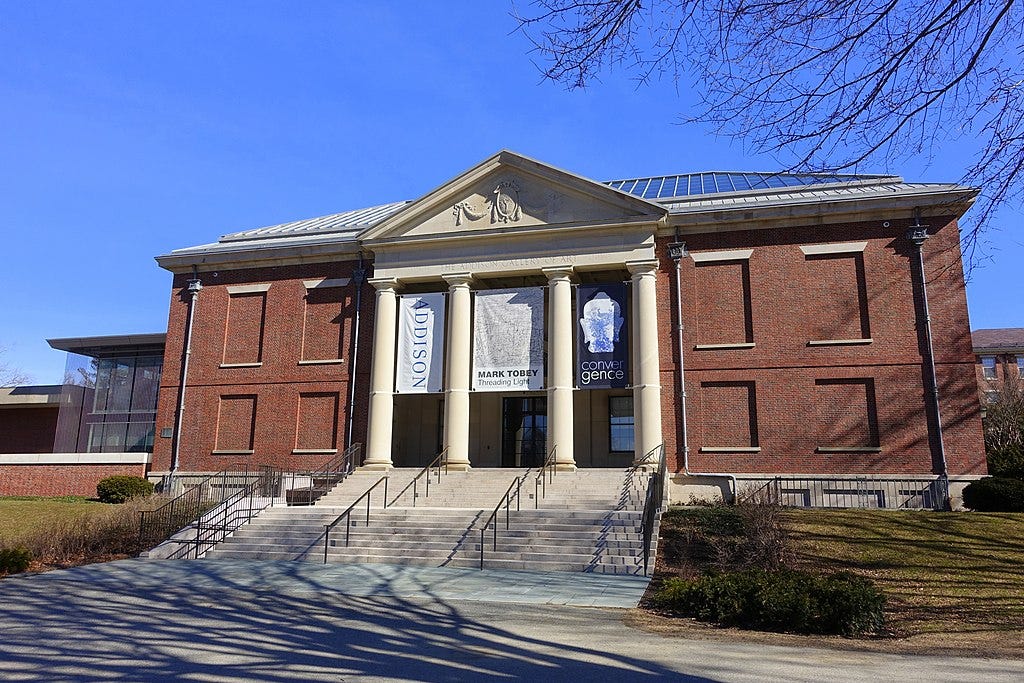Miscellany Mondays: The Addison Gallery's 90th Anniversary
The public side of a private institution
Hello History Buzz readers! We’re three months into our History Buzz experiment, and we’d love your feedback on how we’re doing. We’d like to know more about you, what you’ve liked, what you haven’t liked, what you want more of. If you haven’t yet would you do us a favor and fill out our first reader survey? It’ll remain open until June 22.
2021 is the Addison Gallery’s 90th year. Founded exclusively for American art, it is one of the first of its kind in the world. Its roots trace back to the late 1920s when Phillips Academy alum Thomas Cochran envisioned a transformed Andover campus.
Cochran, a banker, made a fortune on Wall Street. With no heirs, he looked to his alma mater to spend it.
As money was no barrier, he hired architect Charles Platt to redesign Phillips Academy’s campus, especially the section east of Main Street recently acquired from the Andover Theological Seminary.
There is a debate around who first proposed the idea of a gallery. On the one hand, Cochran had connections to some of New York’s prolific art collectors, but Platt had a keen interest in promoting “instruments of culture” through his work.
Regardless, it’s likely neither would have completed the project on their own.
The gallery became the centerpiece of Cochran’s plan to transform Phillips Academy and “to enrich permanently the lives of the students.” Flanked by the Oliver Wendell Holmes Library to the south, the two “instruments of culture” face outward toward the street as if displaying themselves to the public. In between them is the allée or Vista lined with American elm trees, beginning at Samuel Phillips Hall and ending at Old Campus Road.
An art museum needs artwork. Cochran called upon his family and friends from New York to donate works to the gallery. He even attended auctions himself to buy pieces directly.
From 1928 to 1935, he collected almost exclusively for the Addison, spending about $800,000 of his own money. That equates to $15.7 million today. Most of the pieces he purchased came from Macbeth Gallery in New York.
The speed at which the collection grew is notable. Collections of equal importance at the Whitney Museum of American Art or Metropolitan Museum of Art “formed over a considerably longer period of time.”
Out of patriotism and an interest in the history of Phillips Academy, Cochran built a collection exclusively for American art, an uncommon idea at the time. In fact, the gallery’s terms of trust written by Cochran prohibit the acquisition of non-American art, with a few exceptions.
By 1930, Cochran had purchased 30 paintings and received another 58 from his friends. The collection was traditional and included works by Winslow Homer, Edward Hopper, John Singer Sargent, and several others. There were no abstract or modernist works.
The gallery takes its name from Kenturah Addison Cobb, a friend of Cochran’s but with no connection to Phillips Academy or Andover or art for that matter. A theory is that he wanted the gallery to appear at the top of alphabetical lists.
To top off the project, Cochran appointed a venerable group of people from the art world to manage the gallery’s collection: himself, Charles Platt, Robert G. McIntyre, principal of Macbeth Gallery, Lizzie P. Bliss, and her sister-in-law Mrs. Cornelius N. Bliss, Jr., both wealthy New York art patrons.
The Addison Gallery opened in May 1931 with 400 works but Cochran continued to buy art and donate to other school projects. In 1935 he became too ill to attend auctions and he died the next year.
In the 90 years since its founding, the Addison added significantly to its collections, notably in photography. However, the collection created by Cochran remains the gallery’s most significant acquisition.1
From May to December 2021 the Addison features an exhibition commemorating its 90th anniversary. The works tell the history of the gallery and are supplemented by letters, plans, and sketches.
Further reading
Addison Gallery Exhibition: Learning to Look: The Addison at 90
Susan C. Faxon, Addison Gallery of American Art: 65 Years (Andover, MA: Addison Gallery of American Art, 1996), 17-110.






Very interesting read. When I was young I used to love walking through the gallery looking at all the art work. Gwendolen Young Devoe
When I was a child, in the '40s and early '50s, I liked to go to the Addison to see the ancient things - Roman plumbing pipes, Egyptian masks, etc. I wasn't interested in American art. You don't mention the ancient things in the article. What happened to them? And how did they get to the Addison in the first place, if the donor was only interested in art?